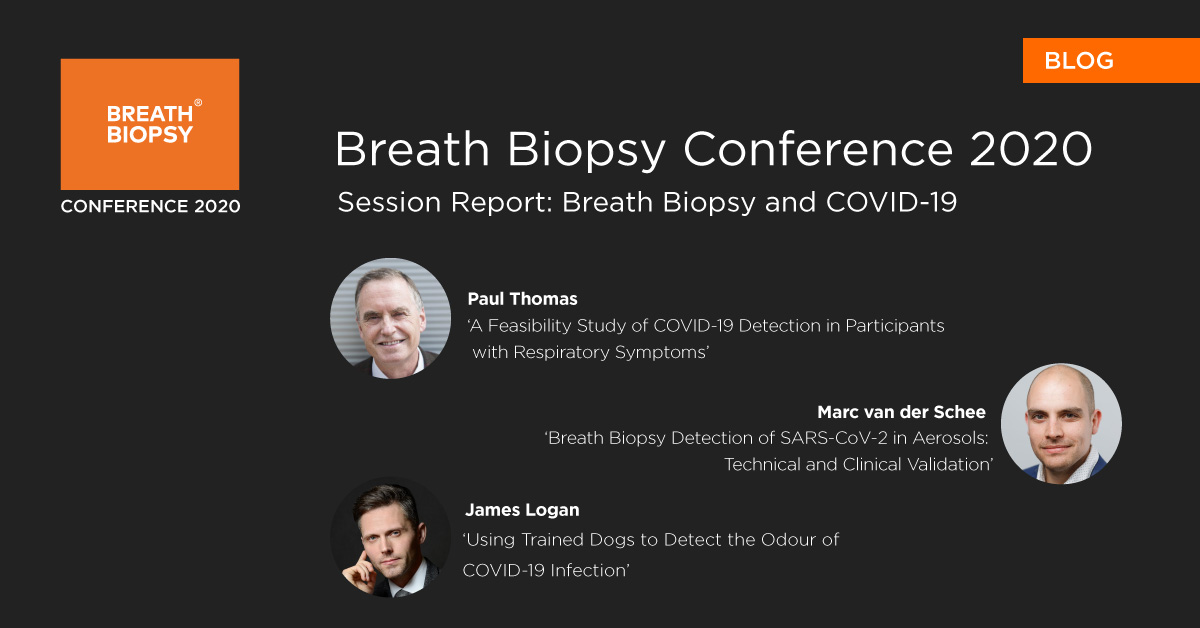Breath Biopsy Conference 2020: Breath Biomarkers for COVID-19
Published on: 30 Nov 2020
The third annual Breath Biopsy Conference took place on 10–11 November 2020. After a year dominated by COVID-19, how has it affected breath research?

The impact of COVID-19 on the Breath Biopsy® community has been dramatic, and goes far beyond the digital format for this year’s Breath Biopsy Conference. In less than a year, the COVID-19 pandemic has made breath testing – particularly of respiratory droplets – a topic of popular interest that has seen the launch of numerous research studies and collaborations across the field. We have previously covered some of this work on our COVID-19 research page.

The session on Breath Biopsy and COVID-19 opened with Dr Marc van der Schee discussing the work that Owlstone Medical has been doing. He provided a thorough introduction to the context of breath research on COVID-19, including the rapidly developing global situation and the means of transmission for the SARS-CoV-2 virus.

The ability for the disease to spread from asymptomatic patients sets COVID-19 apart from other life-threatening infections and has been a key factor in disease spread. A test that can detect infection earlier, with fast turnaround of results, is critical to controlling transmission.
The ReCIVA® Breath Sampler allows simultaneous collection of both breath VOCs and exhaled breath aerosols (EBAs). Exhaled aerosols can contain virus particles and provide a straightforward, non-invasive way to detect COVID-19 in combination with established PCR analysis tools. EBA also has potential for use in microbiome analysis as well as for detection of proteins and non-volatile metabolites.
Although van der Schee was not yet able to share COVID-19 results using ReCIVA, he shared preliminary data suggesting the quality of EBAs collected by the ReCIVA compared favorably to existing EBA collection methods. COVID-19 has also been successfully detected on these samples, significantly out-performing ‘impact samplers’. More work is needed to assess whether collecting EBA can reliably outperform swab-based tests.
Watch Marc van der Schee at BBcon20
Professor Paul Thomas from Loughborough University is well-known in the breath research field, particularly for his work in asthma and COPD. Thomas’s work on COVID-19 came about as a result of his role in leading the European-funded TOXI-Triage project, working across disciplines to understand and improve the response to emergency situations.
As with so many studies, COVID-19 brought a stop to a TOXI-triage clinical project looking at response to radiation exposure, which was being run in partnership with the University of Edinburgh. Keen to support the emergency response to the pandemic, Thomas and his colleagues shifted their focus to COVID-19. This new focus was mirrored by a separate team based in Dortmund and the two teams have since united with the goal of collecting breath samples from 200 symptomatic patients and 50 controls across the UK and Germany.

Both groups use GC-IMS for chemical analysis providing an easy-to-use system that gives rapid results in a hospital setting. Based on preliminary results, 11 features were of diagnostic interest including ketones, aldehydes and methanol – markers associated with stress and inflammation. The study also identified an unknown feature, Feature 144, which was particularly predictive of poor clinical outcomes. The work is now published in Lancet eClinical Medicine.
Professor James Logan closed the session with a different approach to COVID-19 detection. Logan and colleagues at the London School of Hygiene and Tropical Medicine (LSHTM) have been collaborating with the charity Medical Detection Dogs to train dogs to detect COVID-19. This is not a new idea and dogs are already being trained to detect cancer and Parkinson’s disease. Before the COVID-19 outbreak, Logan was already investigating using dogs to smell malaria.
It’s well known that malaria is carried between people by mosquitos and evidence suggests that people infected by malaria are more attractive to mosquitos because of the way they smell. The odor profile of patients during infection can even differentiate between strains of malaria. While mosquitoes cannot be used as portable detectors, specially trained bio detection dogs are able to differentiate between sweat samples from malaria patients and controls in a lab setting with 81% sensitivity, 92% specificity.

In their work on COVID-19, Logan’s team are recruiting asymptomatic and mild COVID-19 patients from 24 NHS sites. Patient odor is collected on facemasks, socks and t-shirts for the dogs to smell. It’s estimated that a dog could be trained in six to eight weeks and would then be able to screen up to 250 people per hour.
It seems likely that the application of breath research for the detection and monitoring of respiratory infections like COVID-19 will continue to be a key research theme for years to come – with great potential for breath testing to slow the spread of diseases and prevent future pandemics. Whether this is achieved through EBA’s or VOCs, spectrometry or sensors, or even with dogs, remains to be seen. If you’re interested in using breath to research COVID-19 find out more.
If you weren’t able to attend the Breath Biopsy Conference 2020 live, or you want to see any of the presentations again, don’t worry. The whole conference, including the COVID-19 session, is now available for you to watch on demand, for free.
